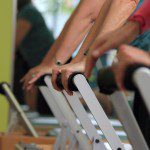In our last blog, Pilates – Expectations, we discussed what the overall expectations for a student of Pilates would be depending on the level of practice. We focused on the all-around expectations, and now we want to have a more in depth discussion about what is experienced once a student is past the beginner level, or in other words, what is beyond the basics.
You might wonder what is considered beyond basic – while this is seemingly a relative term, but in the practice of Pilates, it’s what lies beyond the initial fifteen lessons. As mentioned in the last blog, by this point, the student will start recognizing exercises by name and their corresponding equipment, and due to naturally connecting their breathing and movement, they will be able to work at a quicker pace without a need for direction from the instructor. This is also where customization of Pilates can come into play, incorporating dynamic movement and modifications suited to individual needs. This is what the late Bob Liekens would refer to as the “ideal” situation for any Pilates practitioner. It is at this point where an instructor can safely start to incorporate more challenging exercises, but for most Pilates students, this is where they find the most satisfactory results, and many tend to stay in this intermediate level for a longer time.
When discussing the advanced level, Bob would refer to it as the “challenge” stage. At this point, one can choose to practice solo, in an advanced group, or simply advance the exercises of the method. An advanced student will have the ability to flow through a controlled and efficient workout, and can activate muscles on demand or adjust positioning while on an unstable surface without assistance. It is at this point where some may train to become instructors themselves.
One constant in Pilates is consistency of practice, not only in the amount that is practiced, but also in the way that it is practiced. A student of Pilates spends those first fifteen lessons learning the proper technique and movement so that as they evolve into intermediate and advanced levels, they subconsciously become masters of Pilates and not just wasting time doing an exercise with no vital benefits. It is also about transforming oneself over the course of practicing in order to live life to its fullest as you age, and understanding that by putting in the work at first, you will reap the rewards later.
“Physical fitness is the first requisite of happiness.” – Joseph Pilates



